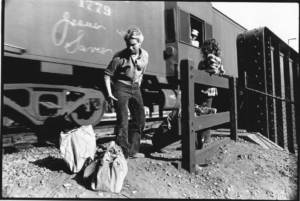In the many years of teaching classes and workshops in street photography I have learned that most photographers face the same obstacles in their search for more effective photographs. Here are five rules, or tips, which I have discovered over the years that have helped my students become better street photographers.
1. No posing or anything contrived.
Follow the straight and narrow road of the great photographers. In my 43 years of study of “Street photography” I have learned that the most basic rule is that there should be no posing or anything artificially contrived. It is this main rule, which gives the genre its highly sophisticated reputation. Yes, it is very difficult to snatch something of value from the ever flowing and constantly changing flow of life, but with a determination to improve, and a lot of practice, you will be able to move about freely and unnoticed in the passing parade of life.
2. Prepare for the moment of truth
Practice operating quickly and effectively when a subject is presented to you. Most unprepared photographers seem to freeze up at the moment of truth because they are unable to follow a well practiced plan of what to look for and what to check when evaluating a possible subject. This must be a conditioned reflex action of great speed, if you to arrive at an accurate rendering of the magical moments that are found in everyday life situations.
3. Rule of “3”
When evaluating the photographs of the greats becomes it is apparent that the best photographs contain many elements, factors and details that the photographer arranged only by careful evaluation and an awareness of how valuable these many details are when “framing” the subject and only including the details that give the center of interest added strength. I don’t look for one thing, but at least three things to combine so the photograph has the ability to “speak” for itself. Therefore, no caption and no explanation of why the photograph was made will be necessary. The only caption should be the place and date of the photograph. When showing photographs if you remain silent you will not dilute the viewers experience by talking about the photograph, so you will get a natural reaction.
4. No cropping.
Henri Cartier-Bresson used a black border to show that he did not need to crop his photos. The black lines are caused by enlarging the negative holder in the enlarger so that it includes the clear edge of the negative and makes it print black, thus proving that the photograph was not “cropped”. These black lines are etched into my mind, so that when photographing the lines are always there to remind me to be very attentive when framing the shot. No cropping.
5. Get in close
My favorite photographers, Robert Frank, W. Eugene Smith and Henri Cartier-Bresson, where gentlemen photographers. They didn’t rush up to scare some old women to get a cheap shot of someone up close. They moved smoothly through life, mostly being invisible to those around them so they could get so close to their subjects. They worked with the greatest respect for the subject, for themselves and for photography itself. Be very strict with yourself and know that street photography is a very difficult and requires great speed from the photographer. You need to develop great speed in thought and great speed in the operation of your body and camera.
To be able to do this work is the gift of a lifetime that most people are unaware of until they see great photographs that have the ability to provide a more compassionate understanding of our brothers and sisters all over the world. Visual documents that give the viewer hope, joy and a better sense of self.



2 thoughts on “My Five Rules of Street Photography”
I was extremely pleased to discover this page. I want to to thank you for ones time due to this wonderful read!! I definitely appreciated every part of it and I have you bookmarked to look at new information on your web site.
Thank you!